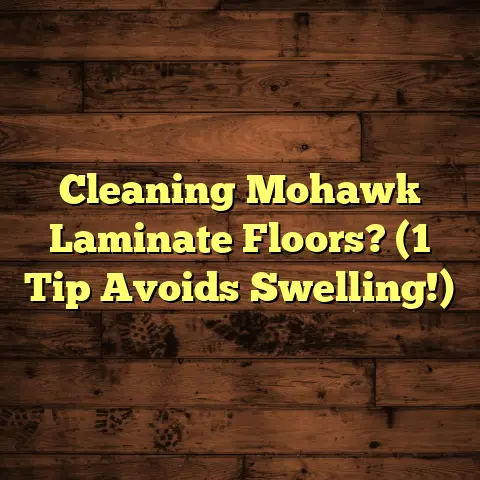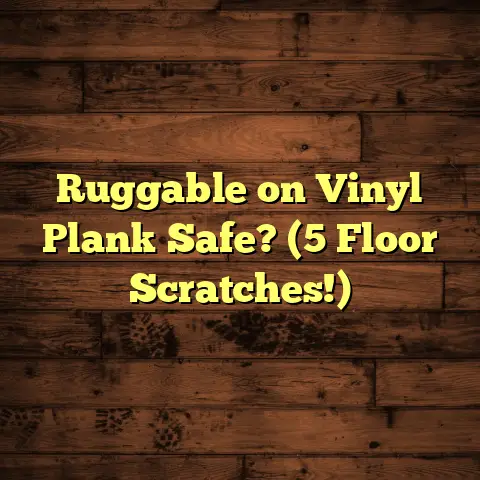Blue Ridge Hardwood Reviews: (1 Mistake to Avoid!)
(1 Mistake to Avoid!)
Choosing the right flooring can feel like a huge
decision, especially when you have kids running
around.
I know the feeling!
As a flooring contractor
with years of experience, I’ve seen firsthand how
much of a beating floors can take from little ones.
Durability, safety, and ease of cleaning become
top priorities.
Scratches, spills, and potential
slips are always on your mind, right?
That’s where Blue Ridge Hardwood comes in.
It’s a popular option, and for good reason.
But before you jump in, there’s one common
mistake I see parents make all the time when
choosing this flooring.
I’m here to help you avoid
it and make the best choice for your family.
Let’s dive in!
Section 1: Overview of Blue Ridge Hardwood
Blue Ridge Hardwood is a brand that’s been around
for a while, known for offering a good balance
of quality and affordability.
They’re not the
highest-end, most luxurious brand out there, but
they provide a solid product at a reasonable price
point, which is appealing to many families.
Their mission, as I understand it from my dealings with their distributors, is to provide accessible hardwood flooring options without compromising on basic quality standards.
What kind of products do they offer?
You’ll find a range of options, primarily focusing
on engineered hardwood.
This is important,
because engineered hardwood is generally more
stable than solid hardwood, making it a better
choice for homes with fluctuating humidity levels
(think kids tracking in water or spills happening
frequently).
They offer various wood species like oak, hickory,
and maple, each with different grain patterns and
hardness levels.
You’ll also see different
finishes and stain colors, allowing you to match
the flooring to your existing decor.
Sourcing and Manufacturing:
Blue Ridge Hardwood, as far as I know, sources
their wood from various regions, often emphasizing
sustainable forestry practices.
I always recommend
checking the specific product details for
certifications like Forest Stewardship Council (FSC)
to ensure responsible sourcing.
Their manufacturing processes involve layering
real hardwood veneer over a core of plywood or
high-density fiberboard (HDF).
This construction
is what gives engineered hardwood its stability.
The finish is typically a multi-layer coating that
provides scratch and stain resistance.
What Sets Them Apart?
Here’s what I think makes Blue Ridge Hardwood stand out, especially for families:
- Price Point: It’s generally more affordable than some of the high-end brands.
- Variety: They offer a decent selection of species, colors, and styles.
- Engineered Construction: As I mentioned, this is crucial for stability and resisting warping or cupping.
- Scratch-Resistant Finishes: Some of their lines boast enhanced scratch resistance, which is a big plus with kids.
Do you see why it can be a good option for families with children?
Section 2: Benefits of Blue Ridge Hardwood
for Families with Children
Let’s get into the nitty-gritty of why Blue Ridge Hardwood can be a good fit for your family.
Durability:
This is a big one, right?
Kids are tough on floors.
Blue Ridge Hardwood, particularly the engineered options, are designed to handle wear and tear.
The multi-layer construction and durable finishes help resist dents, scratches, and everyday abuse.Think about it: Engineered hardwood is more resistant to moisture than solid hardwood.
This means it can better withstand spills and accidents.
Plus, many of their products come with a warranty against wear-through, giving you peace of mind.Safety:
Safety is paramount, especially with young children.
Blue Ridge Hardwood often uses low-VOC (Volatile Organic Compounds) finishes, which means they release fewer harmful chemicals into the air.
This is important for indoor air quality and the health of your family.Additionally, some of their flooring options have a slightly textured surface, providing better traction and reducing the risk of slips and falls.
Aesthetic Appeal:
Let’s not forget about looks!
Hardwood flooring adds warmth and beauty to any home.
Blue Ridge Hardwood offers a variety of styles and colors to complement your decor.The natural grain patterns of the wood create a visually appealing surface that can enhance the overall ambiance of your home, making it a comfortable and inviting space for your family.
Ease of Cleaning:
Spills happen.
Messes are inevitable.
With kids, it’s just part of life!
Fortunately, Blue Ridge Hardwood is relatively easy to clean.
Regular sweeping or vacuuming, along with occasional damp mopping, is usually all it takes to keep your floors looking their best.The key is to clean up spills promptly to prevent staining or damage.
Using a microfiber mop and a pH-neutral cleaner specifically designed for hardwood floors is recommended.
Do you think these benefits make Blue Ridge Hardwood an interesting option? I do!
Section 3: Customer Reviews and Testimonials
Now, let’s hear from other families who have
actually installed Blue Ridge Hardwood in their
homes.
I’ve scoured online reviews and forums to
gather some insights.
Common Themes:
- Durability: Many families praise the durability of Blue Ridge Hardwood, noting that it holds up well to kids, pets, and heavy foot traffic.
- Ease of Maintenance: Customers appreciate how easy it is to clean and maintain the flooring, even with kids around.
- Appearance: The natural beauty of the wood and the variety of styles are also frequently mentioned as positives.
- Value: Many reviewers feel that Blue Ridge Hardwood offers a good value for the price.
Here are a few examples of what customers are saying:
“We have two young kids and a dog, and our Blue Ridge Hardwood floors still look great after three years.
Spills wipe up easily, and they haven’t scratched as easily as I thought they would.” – Sarah M.“I was hesitant to get hardwood with kids, but the Blue Ridge Hardwood has been surprisingly durable.
We’ve had a few spills and accidents, but they’ve all cleaned up without leaving any stains.” – John B.“The floors are beautiful and have really transformed our home.
They’re also very easy to clean, which is a huge plus with two messy toddlers.” – Emily L.
Criticisms:
Of course, not every review is perfect.
Some
customers have noted that certain finishes are more
prone to scratching than others.
Others have
mentioned that installation can be tricky,
especially for DIYers.
Remember: It’s always a good idea to read
multiple reviews and consider the specific product
line you’re interested in before making a decision.
Customer reviews can give you valuable insights
into the real-world performance of the flooring.
Section 4: The One Mistake to Avoid
When Choosing Blue Ridge Hardwood
Okay, here it is: the one mistake I see parents make all the time when choosing Blue Ridge Hardwood (or any hardwood flooring, really).
Not Considering the Janka Hardness Rating
What is the Janka Hardness Rating?
The Janka hardness test measures the resistance
of a wood sample to denting and wear.
It
determines the force required to embed a .444-inch
steel ball to half its diameter into the wood.
The higher the number, the harder the wood.
Why is this important?
Because not all wood species are created equal!
Some are much harder and more resistant to dents
and scratches than others.
When choosing hardwood
flooring for a home with kids, you need to pay
attention to the Janka hardness rating.
Why This Mistake Matters:
Imagine you choose a beautiful, light-colored
maple floor because it matches your decor perfectly.
But you don’t realize that maple has a relatively
low Janka hardness rating compared to, say, hickory
or Brazilian cherry.
What happens?
Every dropped toy, every scooted chair, every
energetic playtime session leaves a little dent or
scratch on your floor.
Over time, your beautiful
floors start to look worn and damaged.
You’re
constantly stressed about protecting them, and
you end up spending more time and money on repairs
or refinishing.
How to Avoid This Mistake:
Research the Janka Hardness Rating: Before you fall in love with a particular species or style, look up its Janka hardness rating.
You can usually find this information on the manufacturer’s website or through a quick online search.Choose a Higher Rating: For homes with kids, I recommend choosing a hardwood with a Janka hardness rating of at least 1200 or higher.
Some popular durable options include:- Hickory (around 1820)
- Brazilian Cherry (around 2350)
- Hard Maple (around 1450)
(Note: These are approximate ratings and can vary slightly depending on the specific product.)
-
Consider Texture and Finish: Even with a harder wood, a textured surface or a matte finish can help to hide scratches and dents better than a smooth, glossy finish.
-
Use Area Rugs: Protect high-traffic areas and play zones with area rugs to minimize wear and tear.
By taking the Janka hardness rating into account, you can choose a Blue Ridge Hardwood floor that will stand up to the demands of family life and look beautiful for years to come.
Section 5: Alternatives and Comparisons
While I’m a big fan of Blue Ridge Hardwood for
families, it’s important to consider other options
as well.
Here’s a quick look at some alternatives
and how they stack up:
Luxury Vinyl Plank (LVP):
LVP is a popular alternative to hardwood, and for good reason.
It’s waterproof, scratch- resistant, and relatively affordable.
High-end LVP can even mimic the look of real wood quite convincingly.Pros: Excellent durability, waterproof, easy to clean, budget-friendly.
Cons: Doesn’t have the same warmth and authenticity as real wood, can feel less luxurious underfoot.
Laminate Flooring:
Laminate is another budget-friendly option that can resemble hardwood.
It’s durable and easy to clean, but it’s not as water-resistant as LVP.Pros: Affordable, durable, easy to clean.
Cons: Not waterproof, can sound hollow underfoot, less realistic than LVP or hardwood.
Tile Flooring:
Tile is a very durable and water-resistant option, making it a good choice for kitchens and bathrooms.
However, it can be cold and hard underfoot, which may not be ideal for play areas.Pros: Extremely durable, waterproof, easy to clean.
Cons: Cold and hard, can be slippery, less comfortable than wood or LVP.
How Blue Ridge Hardwood Stacks Up:
Compared to these alternatives, Blue Ridge
Hardwood offers a good balance of durability,
aesthetic appeal, and affordability.
It’s not as
waterproof as LVP or tile, but it offers a more
authentic look and feel than laminate.
By choosing a harder wood species and a durable finish, you can get the best of both worlds: the beauty of real hardwood with the durability needed for a busy family.
Conclusion
Choosing the right flooring for your home is a big
decision, especially when you have children.
You need something that’s durable, safe, easy to
clean, and beautiful.
Blue Ridge Hardwood can be a great option for
families, offering a good balance of quality and
affordability.
However, it’s crucial to avoid the
one common mistake I see parents make: not
considering the Janka hardness rating.
By researching the hardness of different wood species and choosing a flooring with a higher rating, you can ensure that your floors will withstand the demands of family life and look beautiful for years to come.
Remember to also consider other factors like the finish, texture, and overall style to find the perfect flooring for your home.
With a little bit of research and planning, you can create a space that’s both functional and stylish, a place where your family can thrive.
So, what are you waiting for?
Go and get the best floor for your family home!





